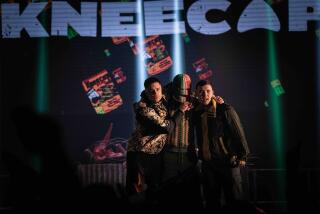Telling a story about telling a story
- Share via
The gothic allure of the opening images hooks you immediately. Here’s Jonathan Pryce, somberly attired, flipping through yellowed photos of conjoined fetuses as a car delivers him to some remote, wind-swept edge of England. Stepping out of the car, he sinks in the mire and is startled by a squawking crow.
The clapboard and “Cut!” come as a surprise, as does the shift to director Ken Russell, sitting in a study somewhere, talking about his never-finished biopic, “Two-Way Romeo.” Russell’s film doesn’t exist; it’s a fiction embedded in a fake documentary about Tom and Barry Howe (Harry and Luke Treadaway), conjoined twins who exploded on the London music scene as the frontmen of the proto-punk band Bang Bang in the mid-1970s.
Directed by Keith Fulton and Louis Pepe (“Lost in La Mancha”) from a screenplay by Tony Grisoni based on a novel by Brian Aldiss, “Brothers of the Head” is told via present-day interviews with the people who knew Tom and Barry when. Aside from Russell, who plays himself, there’s Eddie Pasqua (Tom Bower), a documentary filmmaker and supposed protege of D.A. Pennebaker who insists on the unobtrusive “truth” captured by his intrusive lens, and various lawyers, managers, handlers, photographers and Svengalis.
There’s also Laura Ashworth (played by Diana Kent in the present and Tania Emory in the ‘70s), a young journalist who approaches the twins with the intention of writing about the exploitation of the physically disabled and ends up falling in love with Tom. Quiet Tom falls in love with Laura too, and the explosive but physically weaker and more dependant Barry is overtaken by jealousy.
Paralleling the novel, which is told as a series of first-person accounts by everyone but the protagonists, the movie explores the issue of representation through a jumble of sometimes conflicting, and conflicted, perspectives. The notable difference is that the twins are extremely compelling and charismatic screen presences. Onstage, they explode with an energy that seems strong enough to tear them apart. Offstage, they are a spooky image of insular and interdependent intimacy. Pasqua’s camera is forever intruding on them in the bath and in bed as their conflicting needs for adulation and privacy grow.
After their mother dies in childbirth, Tom, Barry and their older sister Robbie (Elizabeth Rider) are taken by their father to live in a tumbledown cottage near a ruined castle on the remote L’Estrange Head. And when the boys turn 18, he sells them to a devious music promoter and former vaudeville child star named Zak Bedderwick (Howard Attfield).
Bedderwick installs them in Humbleden Hall, a remote country manse turned proto-punk crash pad, and has them groomed into a musical novelty act by his vicious flunky Nick Sidney (Sean Harris) and a laid-back, suddenly band-less Paul Day (Bryan Dick), who teaches them to play music. That the boys turn out to be genuinely talented and attract a huge following comes as somewhat of a surprise to all.
Mixing a lurid, dread-filled gothic style reminiscent of Russell and David Lynch with the documentary aesthetic of Pennebaker and the Maysles brothers, and at the same time evoking the trash-romanticism of Julien Temple’s “The Filth and the Fury” and Bruce Robinson’s “Withnail and I,” “Brothers of the Head” vividly re-creates the spirit of the 1970s British art/rock scene. The plaintive, furious lyricism of Bang Bang’s songs, which were written and produced by London punk-scene fixture and influential music producer Clive Langer and performed by the actors, anchor the mood in such pitch-perfect historical specificity that the story feels truer than fact.
It’s the songs, actually, that give the movie its emotional ballast, countering the filmmakers’ intellectualized approach and meta-narrative style. Although the various cameras rarely turn away from Tom and Barry -- except to show us fictional representations of Tom and Barry, or listen to someone who knew them talk about them -- the twins are largely absent from their own story except as objects of prurience, speculation, fascination and dread.
The insights into the nature of narrative, exploitation and the intersection of both seem better suited to the novel format than to a film as gorgeous and a story as visceral as this. The twins are so magnetic, so wounded and feral and sexy and doomed, that you find yourself longing for a glimpse into their point-of-view, which the movie intentionally -- and later, perversely -- keeps at a strict remove. Tom and Barry’s exit from public life can be pegged to a single moment -- which Pasqua helpfully locates on a single frame. After that they disappear from view, leaving you wanting much more from them than they have been allowed to give. (Which I guess is not the worst thing, considering how many films leave you wanting less.)
Thought-provoking as it is, “Brothers of the Head” keeps its distance, choosing to tell a story about telling stories. But the story itself remains an unexploited gold mine.
*
‘Brothers of the Head’
MPAA rating: R for language, drug use and sexuality
An IFC Films release. Directors Keith Fulton and Louis Pepe. Screenplay by Tony Grisoni from a novel by Brian Aldiss. Producers Gail Egan, Simon Channing-Williams. Director of photography Anthony Dod Mantle. Editor Nic Gaster. Running time: 1 hour, 30 minutes.
In selected theaters.
More to Read
Only good movies
Get the Indie Focus newsletter, Mark Olsen's weekly guide to the world of cinema.
You may occasionally receive promotional content from the Los Angeles Times.








